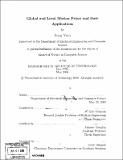Global and local motion priors and their applications
Author(s)
Yuen, Jenny, S.M. Massachusetts Institute of Technology
DownloadFull printable version (19.31Mb)
Other Contributors
Massachusetts Institute of Technology. Dept. of Electrical Engineering and Computer Science.
Advisor
W. Eric L. Grimson.
Terms of use
Metadata
Show full item recordAbstract
With the rising popularity and accessibility of cameras as well as the arrival of popular video sharing websites like YouTube.com, Google Video, veoh.com, and many others, large quantities of video are produced and available everyday. With all this data, it becomes necessary to find ways of understanding the content of videos in large data sets for applications in areas like multimedia management, video surveillance, and many others. At the same time, all this amount of information produced everyday can be used for solving problems that can be difficult without a large amount of training data such as scene matching and alignment. This work studies motion properties across different sources of video. Both the global motion (also known as the camera motion) and the local motion are studied, to extract common properties of similar video sequences. As a consequence, several applications using these types of information arise. In the case of global motion, an application for clustering videos based on their genre is examined. For the local motion, this work describes a way to use a database of flow fields together with matching and alignment techniques for inferring an optical flow field from a single image (as opposed to the standard problem of motion estimation using two adjacent video frames) as well as synthesizing video also from a single image.
Description
Thesis (S.M.)--Massachusetts Institute of Technology, Dept. of Electrical Engineering and Computer Science, 2008. Includes bibliographical references (leaves 61-64).
Date issued
2008Department
Massachusetts Institute of Technology. Department of Electrical Engineering and Computer SciencePublisher
Massachusetts Institute of Technology
Keywords
Electrical Engineering and Computer Science.